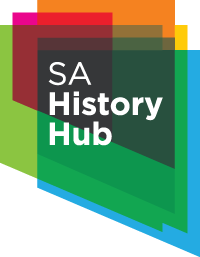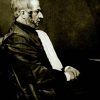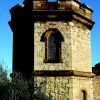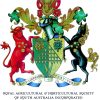Kingston Terrace in North Adelaide is named after Colonel William Light’s deputy, George Strickland Kingston who, on appointment as Deputy Surveyor General in the colony, became the first European thought to have stood on the site where Adelaide now sits.
At 29 years of age he became the youngest officer to be appointed in the colony, a man at the height of his physical powers, which he flaunted by walking incessantly and tirelessly over thousands of hectares between the sea and the hills.
G.S. Kingston was the third youngest of all those named in the streets of Adelaide. Only John Morphett and Sir William Molesworth were younger. Morphett, Lieutenant William George Field (also 29) and Kingston were charged with doing much of the legwork once on shore. A source of fresh water and the embouchure of the River Torrens were uppermost in their minds from the beginning, for no city could be planted without reasonable access to the coast and sufficient rainwater to sustain human settlement. South Australians are indebted to this group of young, physically fit colonists for both discovering and naming the River Torrens, which the first Australians knew as the Yatala.
Kingston introduced his senior officer, Colonel Light to the proposed site for Adelaide on Christmas Eve 1836. Light was impressed, and after an interlude of a few days in which Governor John Hindmarsh tried vainly to move the township a mile or two downstream, he had no hesitation in going with his first instincts: he planted the city on the site Kingston thought best.
Kingston was not present among those deciding the names of the Adelaide streets, which is somewhat of a surprise, given that the Street Naming Committee was dominated by his closest colleagues and friends, most of whom were like-minded republican ideologues. He was otherwise engaged making preparations to sail to London on the HMS Rapid, which sailed from Holdfast Bay for Hobart and London on 5 June 1837 and arrived in November 1837.
The Rapid returned to London for several reasons. With Lieutenant W.G. Field in command, the ship was taking the first produce from the colony back to an eagerly awaiting group of commissioners and South Australian Company directors. Kingston returned to Adelaide with his wife on the Eden, arriving back in the colony in 1838. He also carried the warrant for the Adelaide Freemason’s Lodge No. 1, for which he was to become the Master on 14 August 1838 before subsequently alternating each year with Henry Mildred.
On 27 March 1837 all the previously unsold town acres on the Adelaide plan were sold at auction and Kingston purchased town acre No. 1027 at the western end of Stanley Street, which also butts onto the North Parklands adjacent to Lefevre Terrace. It cost £6, 18 shillings and has one of the best outlooks over Adelaide. This choice suggests Kingston had considerable prior knowledge of the Adelaide plan and the foresight to claim it for himself. It was perhaps one of the most strategic acres in the new settlement, particularly in terms of its amenity, outlook, position, proximity and elevation. It is perhaps therefore not surprising that the adjoining street, which overlooks the North Parklands, was named Kingston Terrace in his absence.
Kingston also purchased Town Acre No. 255 in Franklin Street on the day of the auction and Lot 80 on Pennington Terrace on 15 September 1838. His final place of abode, however, was on the corner of Grote Street and West Terrace, where he faithfully kept the rainfall statistics for the colony from 1839 until 1878.
Ironically, George Strickland Kingston has become one of the more controversial figures discussed among contemporary South Australian historians in the modern era. Several academics have sought to revise accepted history by denigrating the role of Colonel Light in the planning of the city of Adelaide and elevating Kingston instead, although it is true that some earlier writers were unnecessarily hagiographic in their assessment of Light. Some balance is required. Colonel Light was responsible for the plan of Adelaide, which is so highly regarded by town planners, government consultants and the public of South Australia today. The finer details were essentially his because they could only be determined and approved after a careful assessment of the onsite topography. Some idealised features of amenity such as the need for parks and squares may have been considered by Kingston under the supervision of those at the Adelphi.
How did George Strickland Kingston become to be involved with Edward Gibbon Wakefield’s colonisation scheme? After noting an advertisement in the press about a proposed colony in southern Australia, he began by corresponding with Robert Gouger, Secretary of the South Australian Association, in an effort to determine his prospects, before going to London in March to meet the proponents of the scheme. He had no capital.
Kingston was born to an Anglo-Irish family in Bandon, County Cork, in mid-1807. He was delivered at his parents’ new three-storey home on Gallows Hill in the Parish of Ballymodan, on the northern side of the River Bandon. He was baptised at the ancient Christ Church on 27 August. He was the third born of four children. All were educated in Bandon at the exclusively Protestant classical school, just outside of town.
George joined the economic flight from Ireland, which by the mid-1840s was plunged into the depths of a severe famine. By 1822 more than 2,000 residents of Bandon were receiving charity. In this year, Kingston left school, effectively orphaned by the death of his father in 1817 and his mother in 1820. What was left of the family estate passed to William, the eldest son, leaving George with no means of support.
Like Wakefield, Kingston was now faced with the emotions inherent in being deprived of the trappings of an upper middle-class upbringing. This in part accounts for a certain bravado and haughtiness which were to become features of his youthful and exuberant personality. There is little to support the idea that he ever had any formal training in Ireland. He made his way to London, where he presumably met his first wife Henrietta Ann Stuart McDonough, who was usually called Harriet. Just what he did between the age of 15 in 1822 and 1829 when he married Harriet at St Marylebone Church in London is unclear.
In 1840 James Hurtle Fisher became the first Mayor of the Corporation of the City of Adelaide. He took Kingston on as the Town Engineer and later as an inspector of Public Works. Morphett was elected Treasurer.
After Colonel Light resigned as Surveyor General, taking most of the staff with him into private practice, it did not take Kingston long to realise that the task of the role was not only beyond him, but also that the Colonial Office was not going to provide sufficient financial support for it to be undertaken satisfactorily. He too resigned and went into private practice.
Being close to Mayor Fisher and his other friends in the Corporation, Kingston gained some advantage in the procurement of contracts. Accordingly, many of Adelaide’s most significant and architecturally interesting buildings were of his making. Some of his works which still stand include the south-eastern corner of Government House (1839), the original section of the Adelaide Gaol (1840) and John Morphett’s impressive historical residence known as Cummins, not far from the historic proclamation gum tree at Glenelg. Other building commissions included the design of the Roman Catholic Cathedral in Wakefield Street, the Elder Smith & Co. store at Port Adelaide, which is today used by the South Australian Maritime Museum, and the first monument to Colonel Light, raised over his body in Light Square.
In his private life George Strickland Kingston married three times, which was not particularly unusual for the times because so many women died in childbirth. His first wife Henrietta did not come to the colony with him in 1836 because he feared that too much privation in an unknown environment would take a toll on her health. She did, however, come to Adelaide after he returned to the Adelphi to report to the Commission in 1837–38. Unfortunately, his fears for her frailty proved to be correct and she died ten years after they had been married. Their firstborn and only son died soon after.
On 10 April 1841 Kingston took a second wife, Ludovina Catherina da Silva Cameron, with whom he had six children. She was only 17 and he 34. They were married in St John’s Anglican Church in Halifax Street. Their youngest son, Charles Cameron Kingston, later became the twentieth Premier of South Australia and the inaugural Minister for Trade and Customs in the first federal government. Unfortunately, Ludovina also died prematurely, ten years later. She was in her 27th year.
Kingston married for a third time – Emma Lipson was the widow of Thomas Lipson, South Australia’s first Harbourmaster. This union occurred in 1856, which suggests that Kingston until then was alone and raising six children under 10 years of age between 1851 and 1856.
The copper deposits found at Kapunda in 1842 excited a rush of speculative mining exploration and activity, prompting Kingston to become involved in the South Australian Mining Association, of which he became a director. ‘Lady Luck’ shone on him and he never really had to worry about money again, for the ‘monster mine’ he purchased paid fifteen dividends each of 200 per cent for the first five years. Free from penury and with the patronage of those with whom he had emigrated, George Strickland Kingston’s fortunes and status from then on grew substantially. He went on to hold many important influential positions in the colony on his way to power and influence.
As a perpetual supporter of civil and religious liberty he offered himself for the seat of Burra in 1851 and entered the first Legislative Council with a mandate to move as quickly as possible to a bicameral structure with two elected chambers. Elected as the first Speaker in the first parliament in the colony, he held this position almost continuously throughout his long parliamentary career. He represented both Burra and Clare between 1857 and 1862, before standing for the seat of Stanley, which he held from 1863 to 1880.
Kingston was a regular member of the congregation at Holy Trinity, Captain of the East Adelaide Rifles (Battalion) and both Secretary and ultimately President of the Agricultural and Horticultural Society, the organisation which still mounts the Royal Show each spring. He assumed the Presidency in 1858.
For most of his married life he lived on West Terrace within walking distance of the Adelaide Observatory, which used to sit on the present site of Adelaide High School, in the West Parklands.
On 16 February 1870 Kingston was rewarded with a Knight Bachelorhood from Queen Victoria.
Even in late life George Strickland Kingston was described as a man of ‘spritely presence, upright carriage and healthful countenance’; however, by the beginning of 1880 he was suffering from an affliction of the throat, which may have been cancer of the oesophagus. His duties as Speaker in the House were severely affected and his health began to decline quite rapidly. On doctors’ advice he resigned from parliament and, with his daughter Ludovina to accompany him, set sail for India, leaving Port Adelaide on 14 November 1880.
He died on board RMS Malwa and was buried at sea off the coast of Ceylon on 26 November. A public funeral service was held at Holy Trinity Church on Adelaide’s North Terrace.







Comments